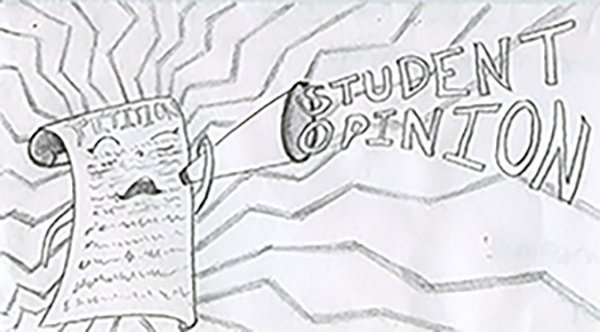Student-led petitions require emphasis on prominent issues, matters

December 16, 2016
It’s 10:00 p.m. and you still have to study for two tests, write a paper and finish math homework. When you check your phone, you see that forecasted snow will probably create a very cold wait for the bus tomorrow. Fueled by the expectation that your commute will be frigid and that you could use the day off to catch up on work, you quickly create an online petition to cancel school and share it on Facebook.
In recent years, students have developed a trend of using organized petitions to request administrative action. While petitions are a powerful way to express our opinion to the administration, the Oracle Editorial Board encourages students to reserve it for use that promotes positive, necessary change.
Following the guidelines to creating a school petition is the first step to making an impact. Dr. Jim Shellard, assistant principal of student activities, cites that a petition must be organized through a club or administrator and must also serve to benefit our collective educational environment. It is crucial that any petition meets the criteria in order to even be considered.
Regardless, the Oracle Editorial Board encourages students to take the extra step to continue the momentum of the petition as a platform for further change. As the petition itself is only a symbol of support, a common misstep is that further action is not taken with it.
In defining the proper use for a successful student-organized petition, we look toward Gay-Straight Alliance’s (GSA) petition last year used to advocate support for creating gender neutral bathrooms. According to GSA sponsor Katrina Prockovic, the club’s petition was made by collecting signatures and then using it as a stepping stone for further conversation, ultimately creating the change.
“[The bathroom petition] allowed us to have concrete evidence of support and then also educate and answer questions from people who were either on the fence or even uninterested to begin with,” Prockovic said. “It was something palpable that the students, […] in doing so, advocated for themselves.”
Where many online petitions fall short is that there is a low level of student follow-up. The end goal of a petition should be to open dialogue and use that dialogue to reach an agreement.
“I think any time we can have a public forum […] where students and faculty can interact with each other and […] exchange ideas and views, support and even dissent-that is really healthy for our community,” Prockovic said.
Noting the plethora of petitions students make that don’t directly associate themselves with positive change or create further dialogue, we suggest students concentrate their efforts on meaningful topics. Tara Tate, AP Government and Advanced Debate Honors teacher, claims that the petitioning process should be used only for topics that are significant to the student body as well and promote positive change.
“Sometimes you want to be careful of starting a petition on anything because it dilutes the relevance and importance of those that are important,” Tate said. “So if students start getting petitions signed for every little thing they want, […] it’s going to dilute the petitions that are of true relevance. So I think students should pick and choose causes that are very important to them.”
Understandably, if these recommendations are taken into account, student petitions would be a much more difficult process to enact. We would need to be patient. We would need to be critical of our intent. We would need to work harder. But imagine the possible payoff.
With proper use, the student-organized petition is a powerful wave of collective support that should warrant serious administrative consideration. As we look to make the best out of our high school careers, we have a right to be heard and promote change, but our words will only have a profound effect when used with impactful, meaningful intent.


